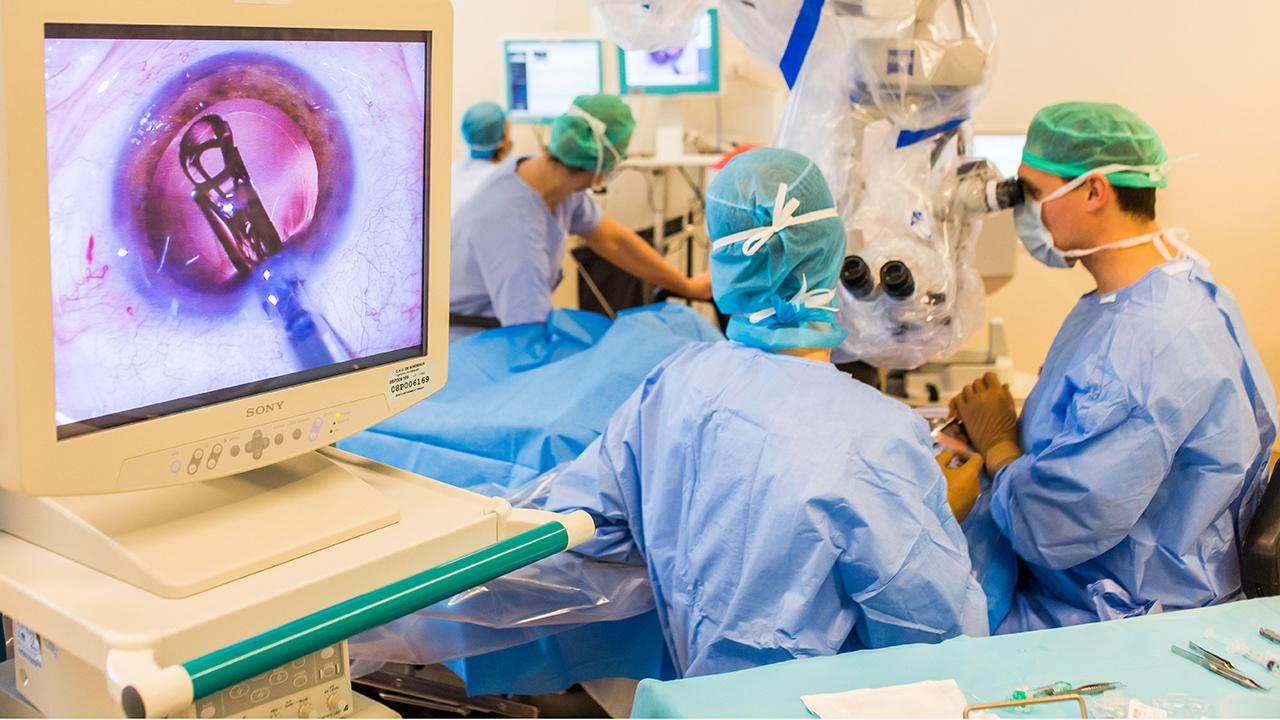

Steroid eye drops reverse cataracts in mice
Science Magazine | Nov. 5, 2015
By Kelli Whitlock Burton
More than half of Americans over the age of 70 have cataracts, caused by clumps of proteins collecting in the eye lens. The only way to remove them is surgery, an unavailable or unaffordable option for many of the 20 million people worldwide who are blinded by the condition. Now, a new study in mice suggests eye drops made with a naturally occurring steroid could reverse cataracts by teasing apart the protein clumps.
“This is a game changer in the treatment of cataracts,” says Roy Quinlan, a molecular biologist at Durham University in the United Kingdom who was not part of the study. “It takes decades for the cataracts to get to that point, so if you can reverse that by a few drops in the eye over a couple of weeks, that’s amazing.”
The proteins that make up the human lens are among the oldest in the body, forming at about 4 weeks after fertilization. The majority are crystallins, a family of proteins that allow the eye to focus and keep the lens clear. Two of the most abundant crystallins, CRYAA and CRYAB, are produced in response to stress or injury. They act as chaperones, identifying and binding to damaged and misfolded proteins in the lens, preventing them from aggregating. But over the years, as damaged proteins accumulate in the lens, these chaperones become overwhelmed. The mutated proteins then clump together, blocking light and producing the tell-tale cloudiness of cataracts.
To treat the condition without surgery—which is out of reach for many patients in developing nations—researchers have looked to drug treatments. Although boosting the function of CRYAA and CRYAB seems to be a good target, developing a therapeutic has been challenging. Most drugs that act on disease-related proteins work by changing how the protein functions, something scientists can measure by monitoring the protein’s enzymatic activity. CRYAA, CRYAB, and similar proteins are known as “undruggable” because their activity can’t be measured, says Jason Gestwicki, a biochemist at the University of California (UC), San Francisco, and a senior author of the new study, published online today in Science.
Gestwicki’s team decided to use a technology called differential scanning fluorimetry, which allows scientists to measure the temperature at which a target protein begins to melt. They analyzed CRYAA and CRYAB and discovered that in one type of hereditary cataract, CRYAB takes on a mutant form with a much higher melting temperature than its normal version. If they could find a molecule that would bind to the mutant CRYAB protein and lower its melting temperature back to that of a healthy CRYAB, they speculated, CRYAB should function normally and prevent damaged proteins from clumping in the lens. The researchers turned to a bank of 2450 molecules that exhibited similar properties to CRYAA and CRYAB. They added molecules to the mutant CRYAB, looking for one that would stabilize their target. They settled on compound 29, a steroid found naturally in the bloodstream but not in the lens, which has no blood supply. Mice with age-related and hereditary cataracts received drops in the right eye, whereas the left eye went untreated. After just a few weeks, the treated eye was visibly clearer, says Gestwicki, who conducted the work while at the University of Michigan. Cataract severity is measured on a scale of zero to four, with four being the worst case. On average, mice in the study had about a one-grade improvement in cataract severity after 4 weeks of treatment.
This is the second study this year to find that eye drops made from a class of steroids called sterols can successfully reverse cataracts. In July, researchers from UC San Diego reported that lanosterol, a steroid found in the human eye, reversed cataracts in dogs.
“It’s a me-too paper in the sense that this new study also treated cataracts with a sterol,” Quinlan says. “But they arrived at the same conclusion by completely different routes. That’s the way excellent science is done, and [it’s] something that should get philanthropists and pharma excited.”
One key difference between the two studies is the way the different steroids were administered. The dog study administered the drug both by injection into the eye and eye drops. The new study used only eye drops.
There’s still a lot to uncover before either study can move into clinical trials, Quinlan notes. The lens in the human eye is very different from those in mice or dogs, and neither study explains how the steroids work on cataracts. “Mechanistically, we really don’t know what’s going on here. It’s a black box.”
Figuring out how the treatment reverses cataracts is the team’s next task, a key step toward clinical trials, which Gestwicki hopes to launch in the next year. ViewPoint Therapeutics, a biotech company he co-founded in San Francisco, California, holds the license to the technology and will launch more animal studies soon.
